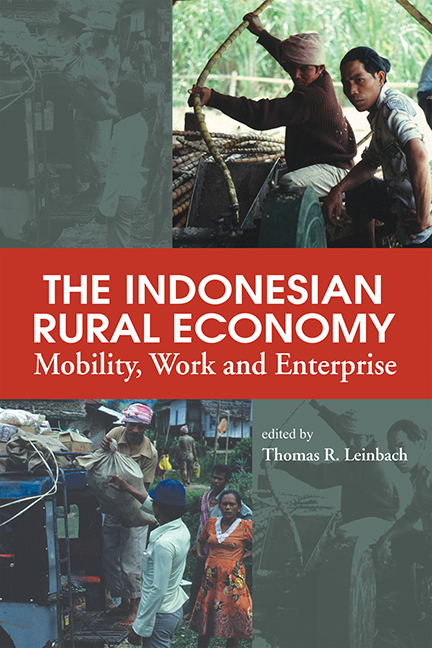Book contents
- Frontmatter
- Content
- List of Tables
- List of Figures
- Contributors
- Acknowledgements
- Glossary
- Foreword
- Part I The Development Context
- Part II Entrepreneurship, Gender and Mobility Issues
- Part III Indonesia's Rural Non-Farm Economy: Case Studies and Policy Development
- Chapter 9 Small Enterprises, Fungibility and South Sumatran Transmigration Livelihood Strategies
- Chapter 10 Transitions to Non-Farm Employment and the Growth of the Rattan Industry: The Example of Desa Buyut, Cirebon
- Chapter 11 Policy Implications for RNFEs: Lessons from the PARUL Project in Indonesia
- Chapter 12 The Indonesian Rural Economy: Insights and Prospects
- Index
Chapter 12 - The Indonesian Rural Economy: Insights and Prospects
from Part III - Indonesia's Rural Non-Farm Economy: Case Studies and Policy Development
Published online by Cambridge University Press: 21 October 2015
- Frontmatter
- Content
- List of Tables
- List of Figures
- Contributors
- Acknowledgements
- Glossary
- Foreword
- Part I The Development Context
- Part II Entrepreneurship, Gender and Mobility Issues
- Part III Indonesia's Rural Non-Farm Economy: Case Studies and Policy Development
- Chapter 9 Small Enterprises, Fungibility and South Sumatran Transmigration Livelihood Strategies
- Chapter 10 Transitions to Non-Farm Employment and the Growth of the Rattan Industry: The Example of Desa Buyut, Cirebon
- Chapter 11 Policy Implications for RNFEs: Lessons from the PARUL Project in Indonesia
- Chapter 12 The Indonesian Rural Economy: Insights and Prospects
- Index
Summary
Continuing evidence from Southeast Asia and around the globe points to the increasing rural household dependence on non-farm employment and income. Yet the rural non-farm economy is quite broad and diverse, and the specific nature of the impacts and characteristics warrant continuing investigation (Ashley and Maxwell 2001). The essays included in this volume provide a rich contemporary perspective on the nature of the nonfarm rural economy in Indonesia. And in an attempt to generalize and capture the essence of the essays, it seems appropriate and useful to summarize briefly the major findings. In addition it is also beneficial to highlight future research needs and policy actions with regard to this seminal theme.
Summary of Findings
In the initial thematic essay using census data, Booth's findings suggest that over the decade from 1984 to 1993 earnings from all off-farm sources accounted for 50 percent of the total incomes of agricultural households. Yet while income diversification is taking place, agriculture is claimed as the ‘main’ source of income. But, it is significant to note that by the mid- 1990s nearly 27 percent of rural households had no involvement in agriculture at all. This data also reveal that dependence on non-agricultural wages and salaries is skewed towards the upper income groups.
As numerous authors have reported, rural households appear to take a longer-term view of income security than merely taking advantage of immediately accessible income opportunities. Diversification in investment behaviour is crucial to families seeking to enlarge and protect incomes over a longer period (Leinbach and Bowen 1992). Investment in land and livestock is especially important in this regard (Leinbach and Watkins 1998).
An important finding in this context is that increasingly rural families appreciate the value of education (Ellis 2000, pp. 296–97). Yet in Indonesia there are significant costs associated with secondary and tertiary education. Thus only the more affluent families can afford to keep children in school to attain qualifications for employment in the manufacturing and service sectors (Booth 2000, p. 93). There are also considerable regional variations in the extent to which rural households in Indonesia have been able to diversify into non-agricultural income strategies. This appears to be particularly true in parts of eastern Indonesia such as East Nusa Tenggara, East Timor, and Irian Jaya.
- Type
- Chapter
- Information
- The Indonesian Rural EconomyMobility, Work and Enterprise, pp. 293 - 306Publisher: ISEAS–Yusof Ishak InstitutePrint publication year: 2003

